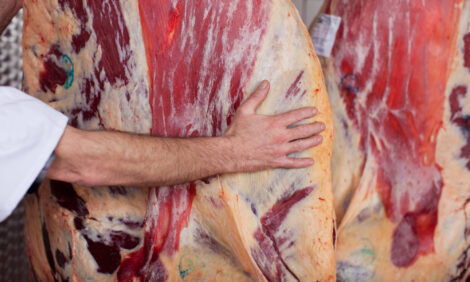



AHVLA Scanning Surveillance Report – May 2011
UK - Bacterial pneumonia causing losses in cattle and sheep and ketosis and fatty liver syndrome in dairy cattle were reported among the diseases diagnosed over the last month, according to the Monthly Scanning Surveillance Report from the Animal Health and Veterinary Laboratories Agency (AHVLA).
Reproductive Diseases
Iodine deficiency
Starcross diagnosed iodine deficiency as the cause of two stillbirths in a group of dairy heifers. Necropsy of one case revealed enlarged thyroid glands weighing 44 grams. The thyroid iodine content was within normal limits, 4869 mg/kg DM (reference range >1200) however histopathology, revealed colloidal goitre suggestive of initial in-utero iodine deficiency followed by supplementation. It was not known at the time of submission during which stage of pregnancy these heifers received the trace element boluses and a review of the timing was recommended.
Campylobacter fetus ss intermedius
Thirsk diagnosed Campylobacter fetus venerealis intermedius as the cause of abortion following necropsy of a foetus, submitted as part of an ongoing investigation where five abortions had occurred over the previous five weeks.
Bacillus licheniformis
Bacillus licheniformis was found to be the cause of four abortions occurring over a three week period in a case investigated by Winchester. The organism was isolated in pure culture from the foetal stomach contents.
Preston also diagnosed the organism as the cause of three late abortions in a group of 15 suckler cows.
Alimentary Tract Diseases
Coccidiosis
Post turnout diarrhoea affecting a 16-month-old Jersey heifer was diagnosed as coccidiosis by Starcross on detection of a high coccidial oocyst count (106,000 opg) in a faeces sample. Although speciation of the coccidia was not carried out, the history, age of the animal and high oocyst count were suggestive of Eimeria alabamensis.
Clostridial enteritis
Winchester diagnosed enteritis caused by Clostridium perfringens as the cause of death of a four-day-old suckler bull calf with a history of sudden death. It was the second animal from a group of 80 to have died. Necropsy revealed necrotising enteritis affecting the small intestine with fluid contents resembling a strawberry milkshake present in the fore-stomachs.
Bloat
A large dairy herd of 2000 cows reported sudden onset bloat affecting nine with seven fatalities. Necropsy of a typical case at Preston revealed a torsion of most of the small intestine which was distended with gas and port wine coloured fluid.
Caecum and colon were also greatly distended with gas and green/brown fluid contents. The problem coincided with the introduction of ration changes.
Substantial amounts of undigested cereal were found in the contents of the small and large intestine – possibly predisposing to the rapid fermentation with gas production of carbohydrate material within the intestines followed by bloating and torsion.
Respiratory Diseases
Bacterial pneumonia
Penrith diagnosed Histophilus somni as the cause of pneumonia and death of a 2-month-old suckler calf. Necropsy revealed evidence of multifocal necrotising pneumonia. Associated cerebellar changes suggested a secondary vascular crisis but there was no evidence of active bacterial infection of the brain.
Bury diagnosed bacterial pneumonia as the cause of death of three suckler calves from a group of around 20 which had been at grass for some weeks and had moved pasture a week previously when they were vaccinated for IBR. Necropsy of an affected calf revealed marked red cranioventral hepatisation of both lungs with a little pleural fibrin with bacteriology revealing Mannheimia haemolytica, Pasteurella multocida and Histophilus somni. Respiratory FATs for IBR, RSV and PI3 were negative and histopathology indicated uncomplicated acute bacterial pneumonia.
Metabolic Diseases
Ketosis and Fatty Liver Syndrome
Ketosis and fatty liver syndrome were common diagnoses during the month. In the South West Langford attributed this to a shortage of grass due the drought.
Starcross diagnosed six incidents with the typical clinical history describing rapid weight loss in recently calved cows (less than 30 days), milk drop, and a poor appetite. In some cases there was evidence of a left displaced abomasum.
Biochemical profiles were all similar showing elevated NEFA, BHB and raised liver enzymes (AST, GLDH).
Penrith also diagnosed a case of fatty liver disease on gross and histological examination of a liver sent in by a practitioner. The liver was from a dairy cow that died suddenly two weeks post-calving following a history of weight loss and poor milk yield. Bury described a case affecting a first lactation dairy heifer 10 days after calving which became ataxic and recumbent with no response to calcium and magnesium. Blood biochemistry revealed BHB of 8mmol/l (ref range 0 -1.2) and NEFA over 2000umol/l (ref range 0-600) indicating severe nervous ketosis.
Other Diseases
Botulism
Penrith investigated two outbreaks of botulism. The first involved 18-month-old fattening cattle where 3/54 had shown evidence of flaccid paralysis and death within a few days. Poultry litter had been spread in an adjacent field eight days previously and then ploughed in after 24 hours. The cattle had only been at grass for 7-10 days. The second case involved two 10-month-old heifers that died with classic signs of flaccid paralysis. Again poultry litter had been spread in an adjacent field recently. For further information on bovine botulism please see the AHVLA website http://vla.defra.gov.uk/science/docs/sci_botulism.pdf
Babesiosis
The carcase of a 30-month old cow was submitted to Langford for necropsy from a suckler herd. It was the second animal to die in similar conditions over a three week period, at pasture. The affected animal demonstrated general malaise, becoming recumbent with signs of pale mucous membranes prior to death. At post mortem large numbers of ticks were found in both axillae. Examination of a blood smear identified the presence of large numbers of darkly stained intracellular parasites consistent with Babesia spp. confirming babesiosis or “Red Water”.
TheCattleSite News Desk


